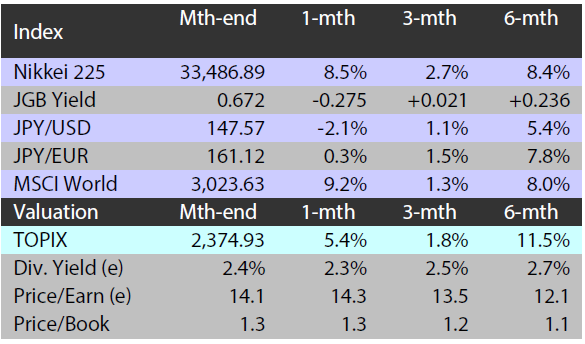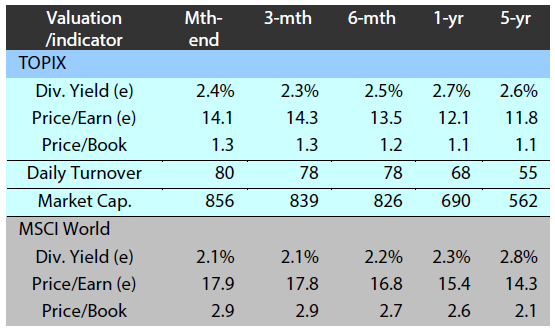As Nikkei touches 33-year high, what seemed out of reach is coming into view
Japanese equities look set to end 2023 on a high note, with the Nikkei Stock Average having gained nearly 30% year-to-date as of this writing. The Nikkei touched a 33-year peak of 33,853 late in November, with the record high of 38,915 marked in 1989 during Japan’s bubble era zenith now appearing on the far horizon. There is more work to be done for the market and the economy, however, before the Nikkei can even attempt to scale that peak again.
First, the Nikkei will have to make a convincing break above the 33,000 level, which has capped the index through much of the second half in 2023. Earlier in 2023 the Nikkei rose from around 30,000 to the 33,000 level, buoyed strongly by expectations that persisting labour shortages would result in secular economic shifts. As we move into 2024, further wage hikes could provide evidence that labour shortages are increasing the spending power of workers. We will be focusing on winter bonuses (for which workers typically receive several months’ salary) as well as the “shunto” wage negotiations held every spring between labour unions and employers to see if they deliver a significant bump in workers’ earnings. If the winter bonuses and shunto negotiations give the market enough confidence that the rise in wages can be sustained over the longer term, it could help the Nikkei climb significantly above 33,000 and towards 35,000.
The next step will be for the Nikkei to build a steady foothold at 35,000. The labour shortage Japan is facing is expected to persist in 2024. Not only will the labour shortage likely keep wages high, but it could also prompt firms to spend more on capex in an attempt to make up for the lack of workers. Such capex activity could increase the efficiency of Japanese firms and boost their labour productivity, providing investors with a fresh growth story for 2024 and paving the way for the Nikkei to challenge 36,000. There will, of course, be potentially tricky developments for the market to digest in 2024, such as changes to the Bank of Japan’s (BOJ’s) accommodative monetary policy. There have been some suggestions that the BOJ’s monetary policy played a significant role in boosting Japanese equities. While the BOJ’s stance has helped, however, the market’s rise is seen to be mainly earnings driven. Equities are therefore expected to remain on a steady trajectory even if the BOJ starts guiding interest rates higher.
Potentially higher Japanese interest rates and lower US rates are expected to have a significant impact on the yen. The yen plummeted against the dollar in 2023, but the situation could be partially reversed in 2024. The Japanese currency may appreciate in 2024, particularly in the second half of the year, on narrowing US-Japan interest rate spreads. It is true that a stronger yen could revive concerns over a possible negative effect on Japanese corporate earnings. However, a strong yen may not be too much of a hindrance to Japanese equities with the market set on the theme of further vitality in the economy on rising wages and increasing capex. The Nikkei may not be able to make a run for the record high in 2024. However, the peak is at least coming into view—a development which was inconceivable just recently.
With Japan set to drop in GDP rankings, time to focus on efficiency, growth
A recent projection by the International Monetary Fund (IMF) that Japan’s nominal GDP in 2023 will be overtaken by Germany and drop to fourth in the world appears to have raised eyebrows in a country still trying to recover from a long period of economic stagnation. It is worth noting that the IMF measures nominal GDPs on a US dollar basis and this has a big impact on rankings. Japan was put at a distinct disadvantage when having its GDP measured in dollars because the yen depreciated significantly in 2023, at one point tumbling to a 33-year low versus the greenback. Germany, in contrast, fared better as the euro gained against the dollar in 2023.
While the projected slip in Japan’s GDP ranking could be blamed on currency exchange rates, the news does provide important food for thought. Japan can learn from Germany, which retains a sizeable economy while only having two-thirds of Japan’s population. Japan is dealing with a shrinking population and Germany provides a template on how to maintain a relatively large GDP with a smaller population. Germany shows that, in order for Japan to maintain its GDP, each individual has to produce or earn more. In short, the country needs to become more efficient as a whole.
The subject of efficiency extends to the equity market as well. Japan’s aggregate market cap is set to decline if the country’s GDP decreases over the longer term. However, even if the aggregate market cap shrinks, a stock index such as TOPIX can remain elevated as long as earnings per share (EPS) remain healthy. And the key to maintaining healthy earnings will be efficiency. Japan is at a demographic crossroad, which is a great opportunity for the government to focus on introducing policies aimed at improving the earnings, profit and output generated by each individual. Japan is already enacting corporate governance reforms, and it can also try to improve capital efficiency by focusing on metrics such as EPS and return on equity. It can be said that scale and stability are for bond investors, while equity investors tend to focus on efficiency and growth. Buying stocks can be likened to purchasing future growth. Japan faces a demographic challenge and its GDP may be eclipsed by Germany’s, but it can still look ahead to improving efficiency and increasing growth.
Market: Japan stocks rally in November on solid domestic earnings
The Japanese equity market rallied in November, lifted by solid domestic corporate earnings and the rise in US equities stemming from lower US long-term interest rates. The TOPIX (w/dividends) gained 5.42% on-month and the Nikkei 225 (w/dividends) climbed 8.53%. The Federal Reserve left interest rates unchanged at the conclusion of its November Federal Open Market Committee meeting while the US consumer price index (CPI) came in below market expectations, further easing the outlook for additional rate hikes. At the same time, Japanese long-term bond yields declined, making Japanese equities appear less richly valued in comparison. These positive factors also buoyed the Japanese equity market.
Of the 33 Tokyo Stock Exchange sectors, 29 sectors rose, with Precision Instruments, Electric Appliances, and Services posting the strongest gains. In contrast, 4 sectors declined, including Pulp & Paper, Mining, and Banks.
Exhibit 1: Major indices
 Source: Bloomberg, 30 November 2023
Source: Bloomberg, 30 November 2023
Exhibit 2: Valuation and indicators
 Source: Bloomberg, 30 November 2023
Source: Bloomberg, 30 November 2023






